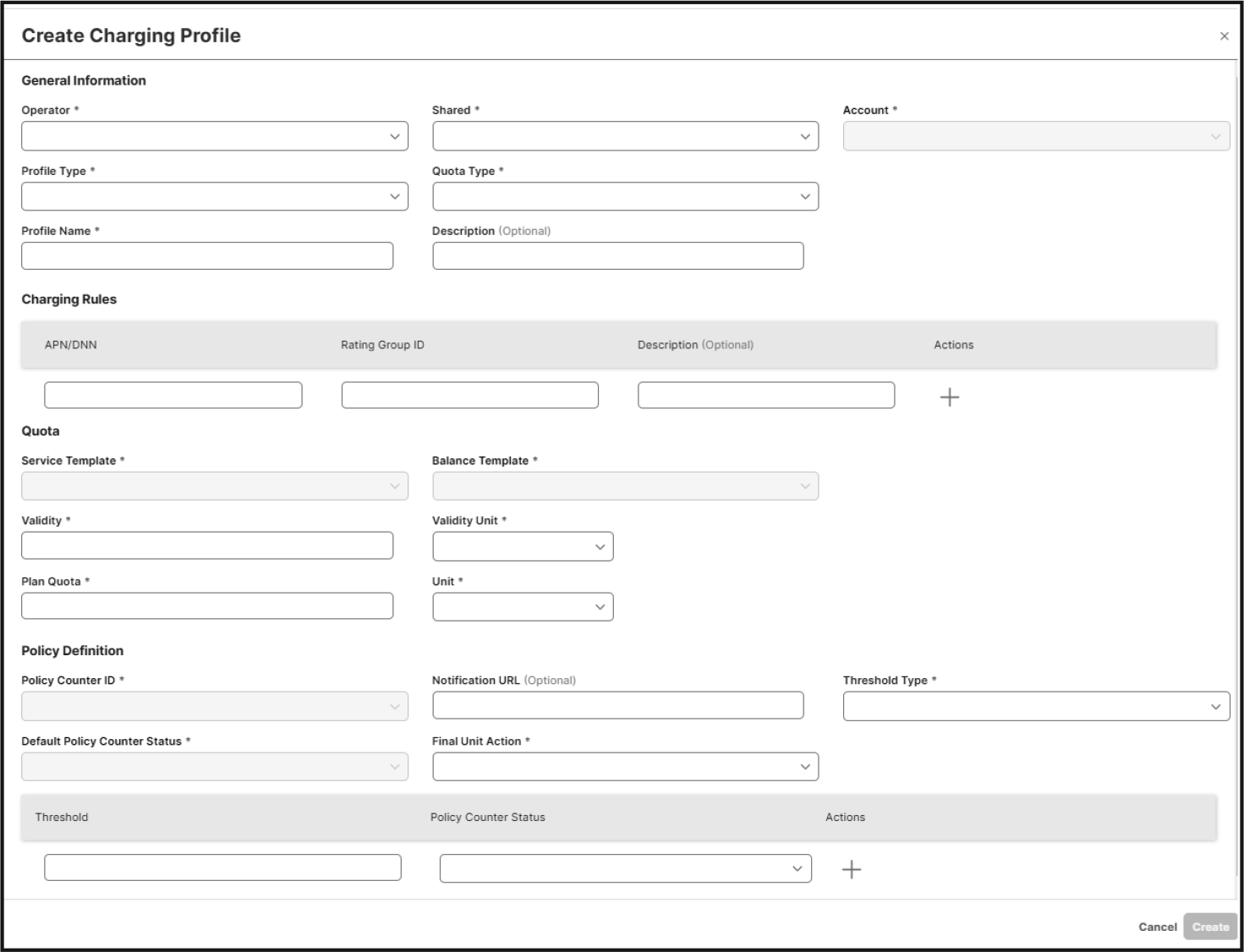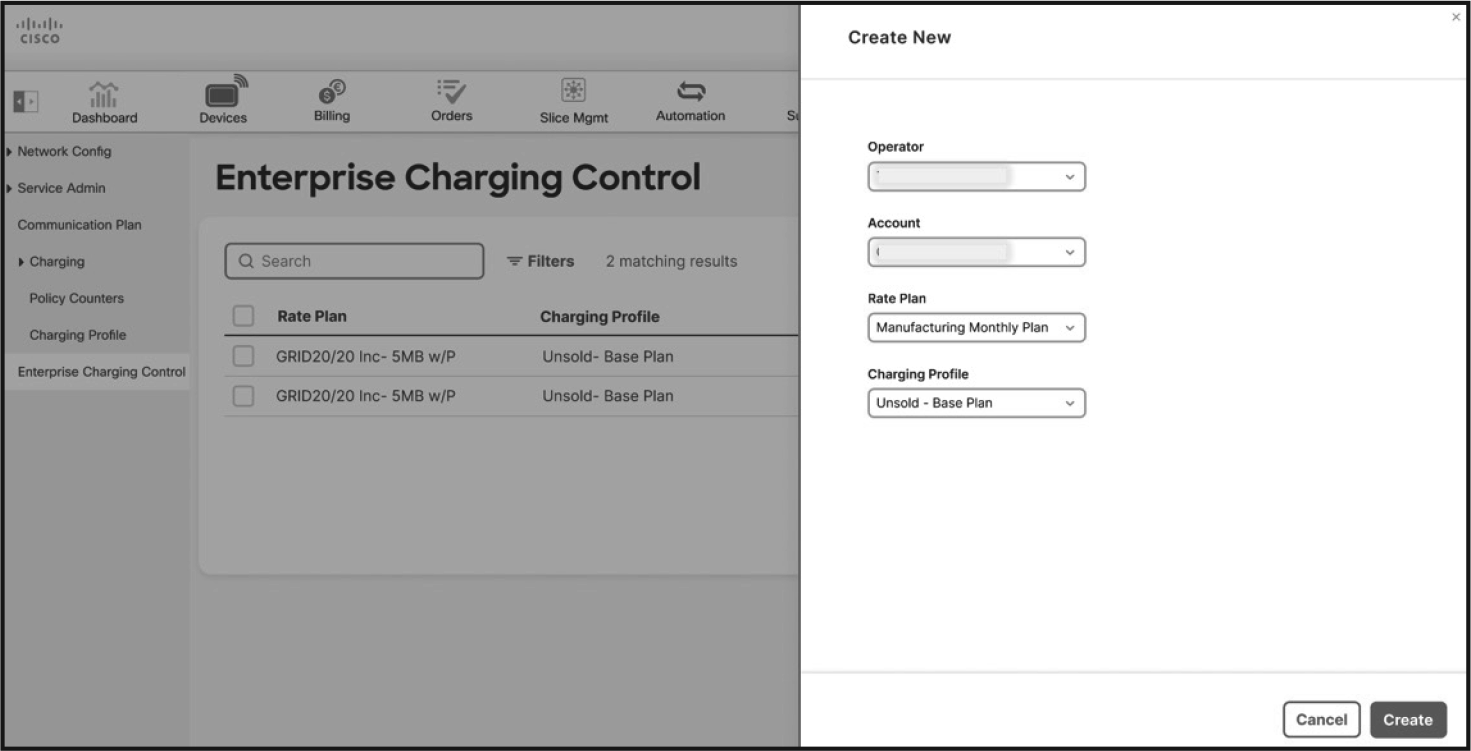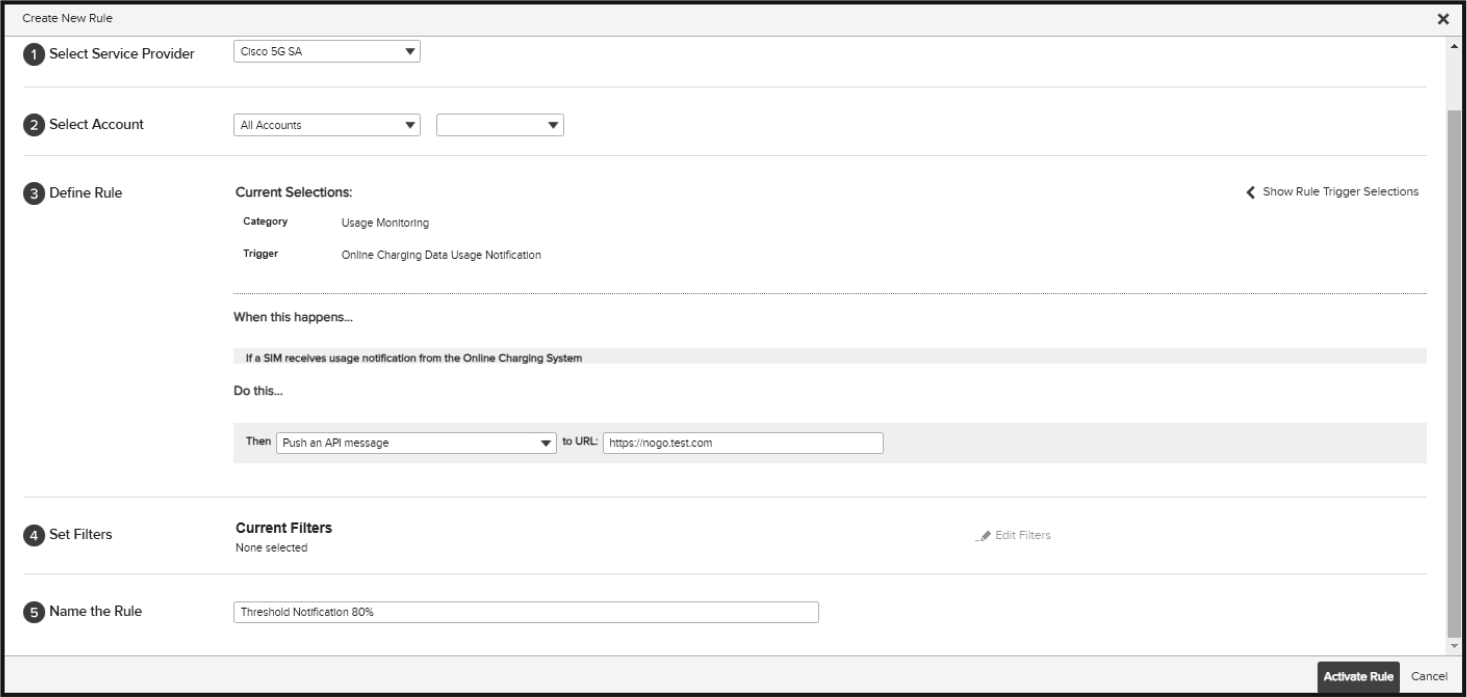Cisco IoT Control Center ‒ Dynamic Policy and Charging Service Solution Overview
Available Languages
Bias-Free Language
The documentation set for this product strives to use bias-free language. For the purposes of this documentation set, bias-free is defined as language that does not imply discrimination based on age, disability, gender, racial identity, ethnic identity, sexual orientation, socioeconomic status, and intersectionality. Exceptions may be present in the documentation due to language that is hardcoded in the user interfaces of the product software, language used based on RFP documentation, or language that is used by a referenced third-party product. Learn more about how Cisco is using Inclusive Language.
Take back control: Launch IoT connectivity-enabled retail subscription services on demand
Imagine giving your enterprise customers the ability to rapidly launch new subscription services, precisely meter data consumption, and offer compelling add-on services – all through a unified experience that maximizes monetization opportunities.
Dynamic Policy and Charging Service, an optional feature of Cisco® IoT Control Center, our market-leading mobility services platform, empowers you with a robust technology stack and intuitive consumption model (UI/API). It enables you to bring innovative, mobility-based enterprise solutions to market quickly and efficiently.
By adding Dynamic Policy and Charging Service to IoT Control Center, you can equip your customers with powerful tools to:
● Create and monetize new subscription-based services effortlessly.
● Accurately measure data usage and charge accordingly for precise billing.
● Upsell value-added services, unlocking new revenue streams.
● Deliver a seamless, branded experience across multiple customer touchpoints.
Unlock your offerings’ full revenue potential and gain a competitive edge with IoT Control Center – the proven platform for powering innovative enterprise mobility solutions at the forefront of innovation.
● Dynamically control the Quality of Service (QoS) for an enterprise application or consumer mobility service by throttling data bandwidth or enforcing real-time policies.
● Enable enterprises to launch new trial or subscription services with recurring prepaid plans and cancellations (in-cycle, pending) to support device lifecycle transitions.
● Enable end customers to stack individual add-on plans (for gaming, in-vehicle Wi-Fi hotspots, etc.) on top of subscription services.
● Provide real-time subscriber-level, threshold-based notifications to trigger purchasing and usage decisions.
● Use REST API-based automation to simplify the enterprise user experience and enable operations at scale.
● Give enterprises full visibility into and control over the service outcomes (utilization, purchasing, etc.) and eliminate revenue leaks for Communication Service Providers (CSPs).
Connected car subscription services
ABI Research estimates that with 5G, more than 50% of the service provider revenue in the next decade will be driven by the enterprise IoT market segment.[1] A testament to this is what we see happening in the connected car industry. The global connected car subscription business is expected to reach about $65 billion, and each connected car OEM is trying to diversify its revenue streams with software-enabled subscription services in support of its growth strategy. For example, General Motors, a major global OEM headquartered in the United States, plans to generate $135 million in incremental revenue per month with new connected, onboard services – Super Cruise, Maps+, OnStar Insurance, OnStar Vehicle Insights, Marketplace, and Connected Dash Camera – as highlighted during its Investor Day 2021 event.
For each of these applications, the enterprises will require some form of real-time data metering, notifications, and options to cancel, since they would be offered as prepaid subscription plans. Service providers have a unique opportunity to capitalize on this market opportunity by empowering enterprises to launch and monetize new subscription services using Cisco IoT Control Center.
Fixed Wireless Access (FWA) mobility services are expected to be a major near-term monetization opportunity for service providers with 5G (or underutilized LTE) spectrum. Dynamic policy and charging control are a foundational requirement to enable these outcomes seamlessly for enterprises.
According to Counterpoint Research, the FWA services opportunity is poised to grow to 462 million subscriptions at a Compound Annual Growth Rate (CAGR) of 22%.[2]
● 4G and 5G FWA subscriptions will reach around 462 million by 2030.
● 5G FWA will have a CAGR of 54% between 2022 and 2030.
FWA services are typically offered as retail packages or subscription services that require data throttling after a predefined data bandwidth with options to buy more bandwidth on demand, which will be data metered. Dynamic policy and charging control are a foundational requirement to enable these outcomes seamlessly for enterprises.
Dynamic policy and charging control is a game-changer for enterprise 5G fixed wireless access, offering unparalleled flexibility and efficiency. It empowers businesses to optimize network resources, enhance security, and manage costs in real-time, while ensuring superior quality of service. This adaptable approach allows enterprises to seamlessly scale their operations, prioritize critical applications, and maintain regulatory compliance, ultimately driving productivity and innovation in an increasingly connected business environment.
Enterprises (fleet management solution providers, connected vehicle OEMs, etc.) are looking to offer subscription services to their consumers (infotainment apps, Wi-Fi hotspots, Advanced Driver Assistance System [ADAS] applications, security dashcams, etc.) as part of their revenue diversification strategy. They are looking for a simple consumption model to enable their customers to subscribe to mobility-enabled subscription services on demand from a web portal, connected vehicle, fleet management device, or consumer electronics device, get threshold-based notifications, and renew or cancel services seamlessly. Service provider partners typically have a set of fragmented vendors, which makes enablement challenging and often results in a sub-par end-user experience.
Dynamic Policy and Charging Services in IoT Connectivity Management Platforms are essential components that enable real-time control over device behavior, network resource allocation, and cost management. These services provide the flexibility to optimize network performance, enforce security protocols, implement usage-based billing, and adapt to changing business needs. By offering scalable, automated solutions for policy enforcement and charging, they play a crucial role in efficiently managing large-scale IoT deployments across diverse industries.
Cisco’s IoT Control Center with Dynamic Policy and Charging Service gives service provider partners the automation, orchestration, and underlying network services they need to empower their enterprise customers to launch their own subscription services with a seamless end-customer user experience.
Communication Service Provider (CSP) partners can choose to get the Dynamic Policy and Charging Service as part of Cisco’s IoT Control Center Advanced Network/premium services offer. They can choose from one of two integration options: a Cisco hosted Converged Charging Function integrated with the CSP’s core network, including the packet gateway and policy control function, or enabled through Cisco’s full-stack IoTaaS solution, which is easy to consume.
For each enterprise application or service that requires data metering, Cisco will enable CSPs with a self-serve option to model commercial constructs for these services with supporting rate plans, onboard quota constructs with charging behaviors, define and onboard policy constructs, and lastly enable the Enterprise Charging Control feature that enforces charging and policy outcomes seamlessly.
Figure 1 illustrates a high-level call flow showing how enterprises can trigger the ability to launch an application or service with IoT Control Center REST APIs and drive integrated outcomes that entail automated subscriber provisioning on the charging function and policy enforcement based on charging constructs. There are three prerequisites to drive this workflow orchestration:

Launch Subscription Services - Generic-UX
1. First, CSP users can leverage IoT Control Center to onboard policy counters that describe what service enforcement is needed based on a charging behavior (downgrade bandwidth, block traffic, redirect to a portal to drive purchasing, etc.). Figure 2 helps articulate the onboarding process. CSPs can also work with Cisco to define these policies on the network and tag each outcome with a counter.

Onboard Policy Counter
2. Second, CSP users will need to create charging constructs that describe the charging behavior (block, redirect, or throttle) based on quota consumption and counter changes (from step 1). Figure 3 illustrates how CSP users can define these constructs from IoT Control Center.

Charging Profile
3. Third, IoT Control Center allows enterprises to assign service plans to charging constructs. This is a key step to automating the entire workflow seamlessly. Figure 4 illustrates the enablement step.

Enterprise Charging Control
As illustrated in Figure 5, IoT Control Center also enables you, your enterprises, or the end customer to get subscriber-level real-time notifications triggered by the charging function, which serves as a foundation to drive purchasing decisions.

Automation Rule - Threshold Based Notifications
Taking back control
In place of those free, over-the-air services, automakers could turn toward revenue-generating services delivered over a 5G connection, whether that’s TuneIn, Spotify or some other streaming app. “Tesla made this decision a long time ago – your Tesla more or less has to be connected and you more or less have to pay at least $10 a month,”
https://www.lightreading.com/5g/automakers-shifting-strategies-could-open-doors-for-5g-providers
Unleashing the power of 5G
“We want to make sure we match the product with the businesses that have the right usage characteristics that we think we can provide a quality level of service.”
AT&T CEO John Stankey
Table 1. Key use cases
| Use case |
Description |
| Connected vehicles |
● Onboard applications (infotainment apps, Wi-Fi hotspots, ADAS apps) for connected car consumers.
● Integrated security dashcam for driver safety (connected car fleets).
● Aftermarket security dashcam solutions for driver safety (commercial vehicle fleets).
● Emergency services requiring on-demand service prioritization.
|
| Enterprise Fixed Wireless Access |
● Unlimited plans with a data cap and automated intervention to drive service prioritization in times of network congestion.
● Throttled plans with the ability to purchase incremental add-ons with automated notifications and triggers.
|
| HD video broadcasting |
● Slice-based network services with an increased data prioritization for a contained duration of time.
● The ability to purchase incremental add-ons (stacked events).
|
| Consumer broadband/enhanced mobile broadband, gaming offers |
● Unlimited plans with a data cap and automated intervention to drive service prioritization in times of network congestion.
● Throttled plans with automated incremental add-ons, based on usage consumption.
|
As a foundational component of Cisco’s Mobility Services Platform, IoT Control Center stands as the industry’s leading connectivity management platform, serving over a quarter billion subscribers today. Dynamic Policy and Charging Service, as an optional feature of Cisco IoT Control Center, provides the robust technology stack and intuitive consumption model (UI/API) CSPs need to bring innovative, mobility-based enterprise solutions to market quickly and efficiently. Cisco also provides connectivity services for more than 50% of these subscribers, built on a robust foundation – an industry-leading converged 5G standalone packet core. With our comprehensive enterprise networking portfolio, Cisco understands the unique needs of our enterprise customers. We are closely monitoring the transition from LTE to 5G to ensure that we are at the forefront of enabling a seamless migration.
Our goal is to build innovative features that can deliver tailored outcomes across industries, connecting people, places, and things through various offerings (private 5G, mobile IoT, consumer broadband, etc.). Most importantly, our efforts are centered around driving monetization up through the connectivity value chain, creating new revenue opportunities for our customers.
Leverage Cisco to launch and monetize advanced network services
Are you a connected vehicle OEM looking to take back control and launch brand new subscription services seamlessly to your consumers? Are you a CSP looking to leverage your 5G (and underutilized LTE) spectrum and launch FWA services with a digital buy flow?
To Learn more about Cisco IoT Control Center, visit: https://www.cisco.com/c/en/us/solutions/internet-of-things/iot-control-center.html.
To learn more about Cisco Mobility Services for IoT, visit: https://www.cisco.com/c/en/us/products/wireless/iot-mobility-services/index.html.
To learn more about Cisco’s Mobility Services Platform, visit: https://www.cisco.com/c/en/us/solutions/collateral/internet-of-things/mobility-services-platform-so.html.
To learn more about the broader 5G IoT market landscape and how to unleash the power of 5G, visit: https://www.cisco.com/c/en/us/products/ collateral/wireless/iot-mobility-services/5g-iot-services-wp.html.
For a demo of IoT Control Center, contact your local Cisco sales representative.
[1] Source: ABI Research, Connected Car, February 15, 2024.
[2] Source: Counterpoint Research, 2023 IOT Connectivity Management Platform Rankings Report.